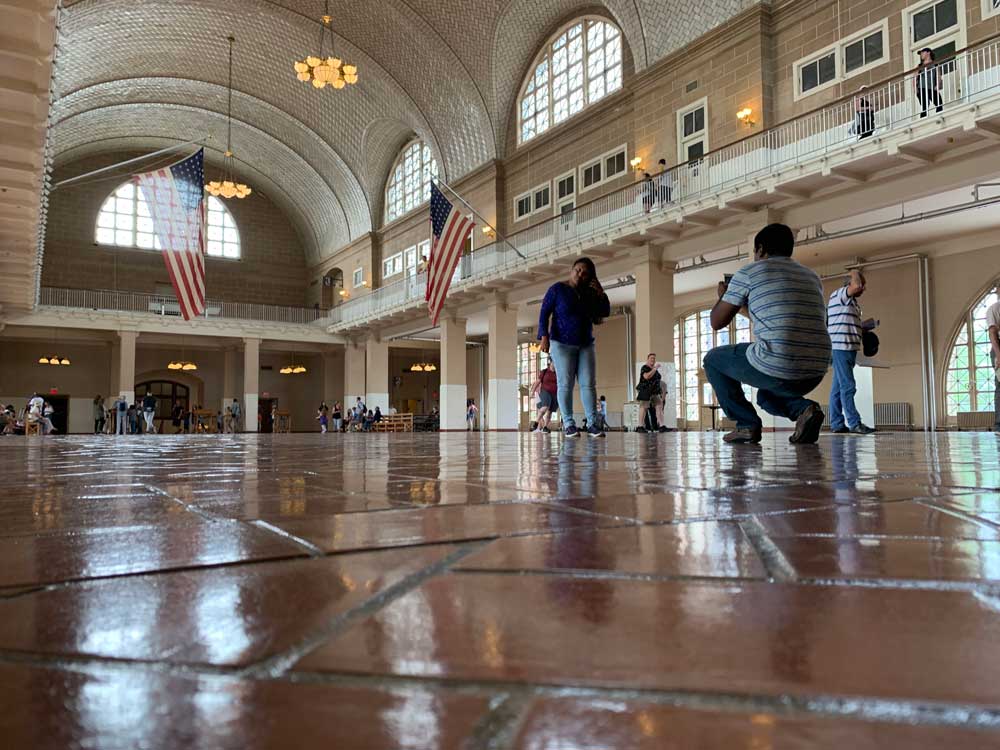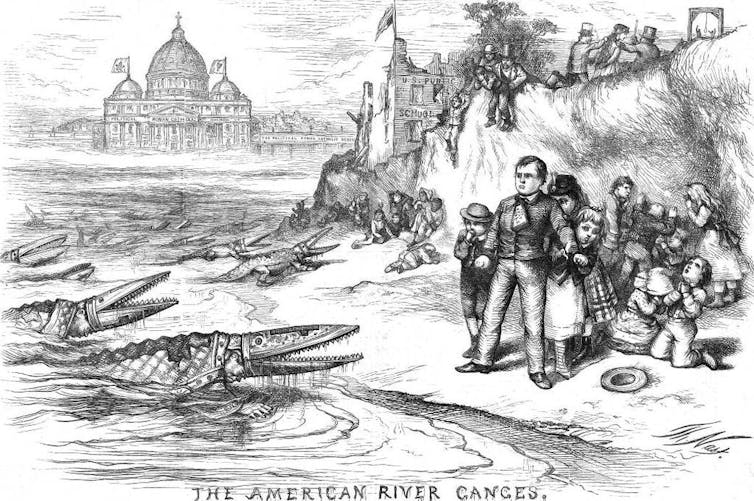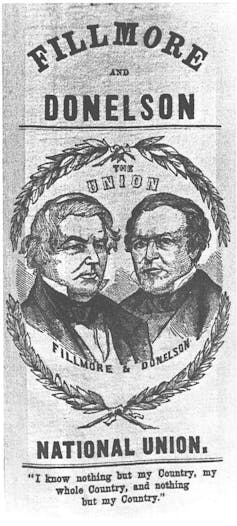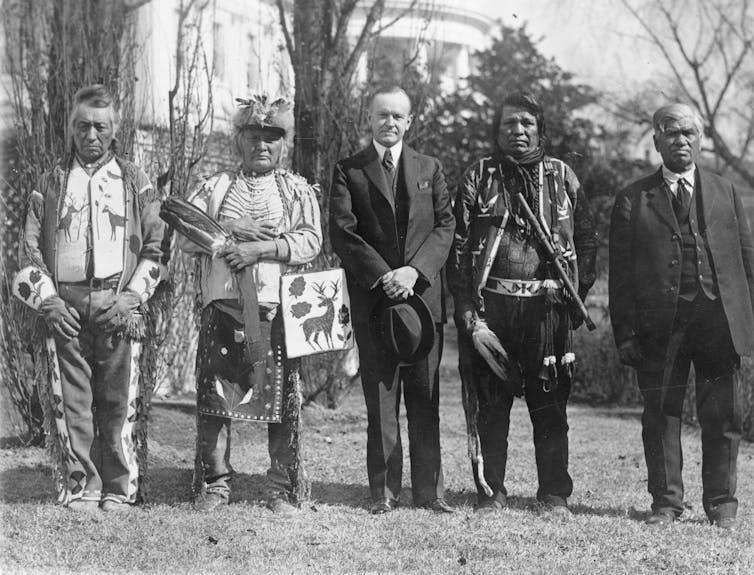
By Matthew Smith
One hundred years ago, the U.S. Congress enacted the most notorious immigration legislation in American history. Signed by President Calvin Coolidge, the Immigration Act of 1924 dramatically reduced immigration from eastern and southern Europe and practically barred it from Asia.
How the law did this, however, was somewhat subtle: a quota. Lawmakers calculated how many immigrants from each European country were residing in the United States in 1890 and then took 2% of that number. Only that many newcomers could be admitted from any particular country each year. Before the end of the 19th century, the number of immigrants from outside western and northern Europe was still relatively small – meaning their 2% quotas would be minuscule.
In short, the Immigration Act was unabashedly racist, seeking to roll back the demographic tide. One of its sponsors, U.S. Rep. Albert Johnson, warned the House Committee on Immigration that “a stream of alien blood” was poisoning the nation.
Torn between “the American dream” and fears of an ungovernable “melting pot,” Americans have always viewed immigrants ambivalently. In 1924, as is true today, many citizens thought in terms of “good” immigration versus “bad” immigration. In their minds, 1890 marked a dividing line between the two.
Looking back as a historian of immigration and religion, I’m struck by three changes in U.S. views of immigration over the course of the 19th century.
Religion, more than race
By the 20th century, eugenicists were obsessing over race. In contrast, early 19th century nativists worried more about religion and how to protect America’s culturally Protestant foundations from Catholic immigrants – most of whom, at this point, came from Ireland and Germany. At the heart of this anxiety lay an old paranoia: Could foreigners confessing loyalty to an infallible pope become faithful citizens of a republic?

Wikimedia Commons
Perhaps so, ventured Cincinnati preacher Rev. Lyman Beecher – but only with great effort on their behalf.
“What is to be done,” he asked, in his influential 1835 tract “A Plea For the West,” “to educate the millions which in twenty years Europe will pour out upon us?”
Many nativists of this time shared similar fears of immigration, declaring that the Catholic Church was orchestrating “a foreign conspiracy” against the liberties of the U.S., aimed at stripping away constitutional freedoms and rigging elections on behalf of Vatican interests.
For Beecher, creating “intelligent, virtuous, and industrious emigrants” demanded public education combined with Protestant influence. By such means, he supposed, patriotic Americans might be fashioned from Catholic populations, who might just embrace Protestant churches along the way. Such thinking was commonplace.
Local, not federal
A second contrast between the earlier nativism and its later 19th century counterpart was the virtual absence of major national immigration legislation. For all their fears of foreign Catholic influence, nativists in the early American republic emphasized assimilation over exclusion. They saw immigration as a cultural, religious and educational concern more than an arena for federal policy.

Wikimedia Commons
The anti-immigrant American Party, or Know-Nothing ticket, did flourish in the 1850s before imploding over the issue of slavery. Know-Nothings enjoyed big gains in state and municipal elections, winning mayoral elections in cities including Boston and Philadelphia.
In Beecher’s hometown of Cincinnati, however, the nativist ticket failed to dislodge the incumbent Democratic mayor. There and elsewhere, Know-Nothing dependence on Protestant German support against the immigrant Catholic vote revealed the frailty of coalition politics and the subjective nature of distinctions between “good” and “bad” immigrants. Likewise, the one major immigration proposal of the American Party – a required 21-year waiting period for new immigrants seeking citizenship – never got past the drawing board.
Although overseas immigration declined in the mid-1850s, Know-Nothing activism did not necessarily explain this downturn. Instead, declining immigration reflected economic cycles, such as the end of Ireland’s peak famine years.
End of an era
The final variable shaping popular attitudes toward immigration was westward expansion. Most Americans regarded the frontier as a pressure valve for their growing country, promising land and opportunity to enterprising settlers. But by the late 19th century, the era of Manifest Destiny – the belief that the country’s destiny was to spread from sea to sea – was nearing the end of its road.

National Photo Company Collection/Wikimedia Commons
Revealingly, the 68th U.S. Congress, which passed the Immigration Act of 1924, also passed the Indian Citizenship Act the following month. The law confirmed that all Native Americans were U.S. citizens at birth, while reinforcing their dependency on reservation lands as wards of the federal government.
The closure of the frontier marked a watershed in immigration history but also a sea change in America’s Indigenous relations. The government integrated Native citizens into the fabric of society, yet withheld the full benefits of citizenship, including guaranteed voting rights.
New era, new prejudice
By the late 1800s, the children of 19th century immigrants – mostly northern Europeans – had largely assimilated into American society, despite the anti-German prejudice that was common during World War I.
Meanwhile, newer immigrants from elsewhere in Europe and beyond were growing in number and experienced discrimination. Immigrants from East Asia, in particular, faced suspicion. The Chinese Exclusion Act of 1882 set a moratorium on all immigration from China, alleging that Chinese immigrants endangered “the good order of certain localities.”

Hawaii State Archives/Wikimedia Commons
Generally speaking, racial rather than religious prejudice dominated anti-immigrant politics by the late 19th century – although these boundaries blurred in the case of antisemitism against Jewish immigrants from eastern and central Europe. The popularity of “racial Darwinism” was at its height: pseudoscientific thinking that misconstrued Charles Darwin’s ideas about evolution, applying ideas such as “survival of fittest” to human society. Many Americans with ancestry from northern Europe embraced the resulting dogma of “Nordic” superiority.
The racism behind the 1924 Immigration Act even prompted a reference in F. Scott Fitzgerald’s “The Great Gatsby,” the celebrated novel published the following year.
“Have you read ‘The Rise of the Colored Empires’ by this man Goddard?” asks Gatsby’s antagonist, Tom Buchanan. This thinly veiled reference alludes to “The Passing of the White Race,” a 1916 manifesto by avowed white supremacist Madison Grant – which was approvingly cited in the congressional debates of 1924.
The record since
The quota system was not repealed until 1965, when President Lyndon Johnson signed the Immigration and Nationality Act, praising “those who can contribute most to this country – to its growth, to its strength, to its spirit.”
Ever since, U.S. immigration has avoided overt discrimination by national origins, with one exception: Donald Trump’s 2017 executive order temporarily barring entry visas from Iran, Iraq, Libya, Somalia, Sudan, Syria and Yemen.
Nevertheless, the Immigration Act of 1924 remains a historical benchmark, reflecting age-old tensions between civic inclusion and racial exclusivity in American life.
![]()
Matthew Smith is Visiting Assistant Professor of History at Miami University.





























Maryanne says
The door of AMERICA has to close and all illegals and their anchor kids must leave
Ray W. says
Time for the next instalment of the Stupidity of the Political Absurdist, Part 1 to Infinity.
This morning, the Bureau of Labor Statistics released its monthly JOLTS Report. The JOLTS Report contains figures for unfilled posted jobs openings, new hires, and turnovers, which includes quit rates, firings, and layoffs. The number is 8.08 million unfilled posted job openings.
For almost all of the past 40 years, the unfilled posted job openings never topped 8 million. Shortly after the jobs rebound from the massive layoffs during the early months of the pandemic, the number of unfilled open jobs broke the 8 million mark. For more than three years, the number of job openings has remained above 8 million, with the peak of 12.2 unfilled posted job openings occurring in early in 2022.
According to the Census Bureau, which has been charged with keeping track of the number of foreign-born residents in our country since its founding, there were 49.5 million foreign-born residents when I last looked several months ago. Even if 11 million are undocumented, we can’t just lose that many workers without seriously damaging our economy.
Let’s think about this. A continuing record number of jobs are going unfilled because we don’t have enough workers. Our economy, though relatively strong when compared to the rest of the world and strong when compared to our own economic history, would be stronger if we had more workers. American women have been birthing fewer and fewer replacement workers, with the birth rate dropping below replacement rate 17 years ago. The replacement rate is 2.1 babies per woman. We are at 1.7 babies per woman and dropping.
Just how is our economy going the ever thrive if we deport the millions of workers who are undocumented? Just how is our economy going to thrive if we stop all immigration?
It is the height of political absurdism, it is the height of stupidity, to purposely destroy our economy by deporting all “illegals” and stopping all new immigration. Pass laws to encourage lawful immigration. Pass laws to adequately fund the asylum claims process, so that those who qualify for asylum can work and those who don’t qualify for asylum can be deported. Pass laws giving amnesty to those who have been here illegally for years so they can legally work. They have been illegally working here for years without problems, so why not make it legal?
Denali says
Start with Melanoma Trump and her parents. She entered the country under false pretenses and became the anchor child for her parents.
Ray W. says
Before this article is booted off the front page of FlaglerLive, I looked around on the internet for material that might counter Maryanne’s claim that all illegal immigrants must leave immediately and that the door on immigration should be closed.
I found an April 12, 2024, Associated Press story headlined “How immigrant workers in US have helped boost job growth and stave off a recession.”
How is it possible for Maryanne to be right at the same time the reporter is?
I decided to read the article.
The author wrote of a significant demographic change that started in February 2020, just before the onset of the pandemic:
“The number of native-born Americans in their prime working years — ages 25 to 54 — was dropping because so many of them had aged out of that category and were nearing or entering retirement. This group’s numbers have shrunk by 770,000 since February 2020. …”
How can one explain a rapidly growing workforce between 2020 and 2024 when the number of American-born workers in the prime working age column dropped by more than three-quarters of a million people during those four years?
This is how the reporter framed this issue:
“In 2019, the Congressional Budget Office had estimated that net immigration — arrivals minus departures — would equal about 1 million in 2023. The actual number, the CBO said in a January update, was more than triple that estimate: 3.3 million.”
This raises the reporter’s great question: “How has the economy managed to prosper, adding hundreds of thousands of jobs, month after month, at a time when the Federal Reserve has aggressively raised interest rates to fight inflation — normally a recipe for a recession?”
She followed: “Increasingly the answer appears to be immigrants — whether living in the United States legally or not. The influx of foreign-born adults vastly raised the supply of available workers after a U.S. labor shortage had left many companies unable to fill jobs.”
She then added: “More workers filling more jobs and spending more money has helped drive economic growth and create still-more job openings. The availability of immigrant workers eased the pressure on companies to sharply raise wages and to then pass on their higher labor costs to their customers via higher prices that feed inflation. Though U.S. inflation remains elevated, it has plummeted from its levels of two years ago.”
So what do the best educated among us say?
The author relied on a speech given last week at Stanford University by Jerome Powell, the Chair of the Federal Reserve Bank.
“There are significantly more people working in the country,” Powell said. The reporter added that Powell also said, in the context of a larger than expected influx of immigrants, that “it’s a bigger economy but not a tighter one. Really an unexpected and an unusual thing.”
The author went to a February 2024 paper published by Douglas Holtz-Eakin, who served as a director of the Congressional Budget Office before becoming president of the conservative American Action Forum. Mr. Holtz-Eakin wrote, “The way to solve an inflation crisis is to endure an immigration crisis.” He also “argued that an immigration cutoff of the kind Trump has vowed to impose, if elected, would result in ‘much, much slower labor force growth and a return to the sharp tradeoff’ between containing inflation and maintaining economic growth that the United States has so far managed to avoid.”
Jan Gautam, CEO of Orlando, Florida’s 44 hotel Interessant Hotels & Resort Management company, employs 3500 workers, 85% of whom are foreign-born. “Without employees, you are broken.” He also said, “If you want boost the economy, it definitely needs to have more immigrants coming out to this country.”
Jenni Tilton-Flood, a partner in Flood Brothers farm in Maine, said of the immigrants who comprised half of the 50 workers who collect 18,000 gallons of milk per day, “[w]e cannot do without them.” Maine currently has two job openings for every unemployed person. Said Mrs. Tilton-Flood: “We would not have an economy, in Maine or in the U.S. if we did not have highly-skilled labor that comes from outside this country.”
“A study by Wendy Edelberg and Tara Watson, economists at the Brookings Institution’s Hamilton Project, has concluded that over the past two years, new immigrants raised the economy’s supply of workers and allowed the United States to generate jobs without overheating and accelerating inflation.”
According to Edelberg and Watson, established economic theory held that employers could not add more than 80,000 to 100,000 jobs per month without risking economic overheating and surging inflation. When they included last year’s immigration surge into their calculations, they found that “monthly job growth could be roughly twice as high this year — 160,000 to 200,000 — without exerting upward pressure on inflation.”
“Ernie Tedeschi, visiting fellow at Georgetown University’s Psaros Center and a former Biden economic advisor, calculates that the burst of immigration has accounted for about a fifth of the economy’s growth over the past four years.”
Why are so many well-educated and experienced economists and businessmen and women arguing that the recent flood of immigrants has actually greatly benefitted our economy?
Why is our economy confounding so many economists who have been claiming for years that recession is just around the corner? Perhaps Heidi Shierholz, president of the Economic Policy Institute and a former chief economist at the Labor Department said it best when she asked, “There’s been something of a mystery — how are we continuing to get such extraordinary strong job growth with inflation still continuing to come down?” She answered her question this way. “The immigration number being higher than what we had thought — that really does pretty much solve that puzzle.”
Here’s my take on the puzzle.
When two successive Congresses voted in a bipartisan fashion to inject $5.9 trillion of unfunded stimulus money into an ailing pandemic throttled economy, and when two successive presidents signed that $5.9 trillion in unfunded stimulus money into law, the size of the injection dwarfed any previous effort to goose an ailing economy. Economists had no reliable model on which to base a prediction for our economy. We were in uncharted waters without an anchor. No one could predict how this spending spree would turn out. What appears to have happened is the onset of an unprecedented economic recovery that defies all predictions. The only answer to the problem created by the injection of so much money into the recovering economy was to add millions upon millions of new workers to produce the goods necessary to meet the demand created by the extra spending. But where were all of these new workers to come from? Our prime labor force dropped by 770,000 workers over the same time period. It had to come from immigration of all kinds and lots of it. We needed every last one of the unexpected extra 2.3 million more immigrant workers who entered our country in 2023. And we still have over 8 million unfilled posted job openings as of May 2024.
If Maryanne were ever to have her way, her solution might be the second-worst thing to happen to our national economy in decades, after the pandemic itself.
Joe D says
OMG….I remember when John F Kennedy was running for President, the Republicans kept pushing that if elected, Kennedy would be GOVERNED by the Pope….NEVER HAPPENED!
I can’t believe back in 1924, they used the “Stream of Alien blood poisoning the nation,” argument….
And here we are with our former President spouting off about immigrat blood poisoning our country 100 years later….have we learned NOTHING!!?
APPARENTLY NOT! And with a current Catholic President, and Presidental re-election candidate! I haven’t heard the POPE complaint recently, but there’s still several months for MUD SLINGING! They’re getting DESPERATE!
Again that old quote: those that fail to LEARN from the PAST, are doomed to REPEAT IT!